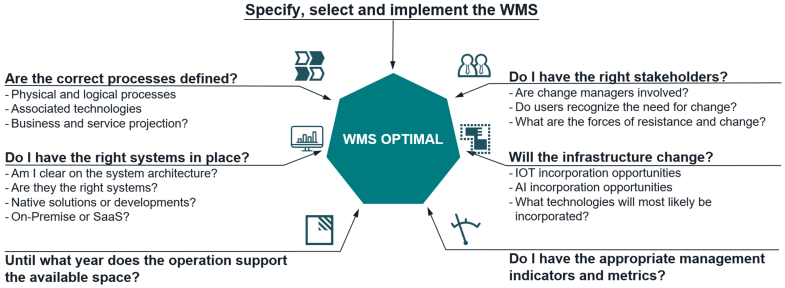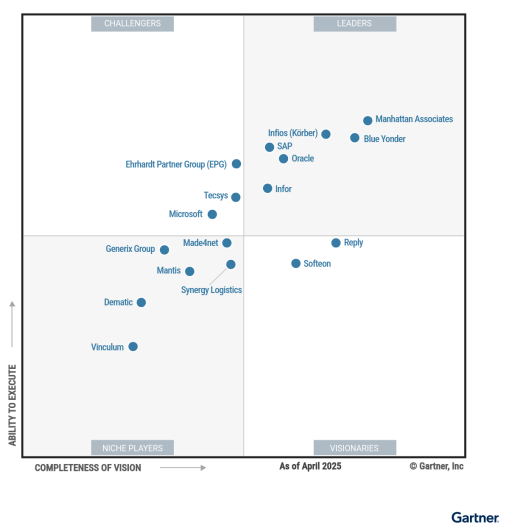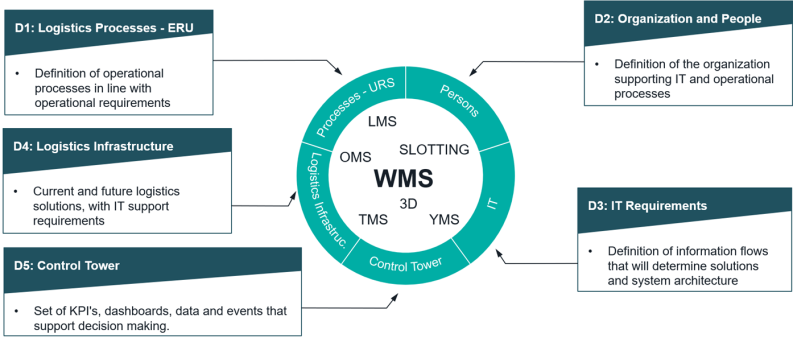What to Consider When Choosing a WMS
02.07.2025
Why your WMS choice matters
Choosing a WMS should address a specific operational need, but it must also align with a long-term vision. It’s essential to consider the local and cultural nuances of each organization. A solution that succeeds in one company or country may not work in another. Even within the same region, digital maturity, organizational culture, and processes vary –so the selection must be guided by a deep understanding of the context.
More than a software decision
Don’t just compare features - think fit
To build a holistic view that supports a robust decision when selecting a WMS, it’s essential to start by asking the questions shown in Figure 1.

Figure 1 – Key questions for selecting the right WMS
The answers to these questions will guide us toward solutions that drive sustainable results, allowing us to dive deeper into key considerations such as:
- Alignment with business processes – not just technical requirements. A detailed URS (User Requirements Specification) should be created for all processes, outlining both the current state (As-Is) and the desired future state (To-Be), based on best practices. The URS becomes the foundation for the system’s functional specifications and configuration.
- Scalability. The system must grow with the operation. It’s critical to understand the different modules the solution offers and its roadmap to grasp the software’s focus and the new tools it will introduce to enhance efficiency, profitability, service levels, and more.
- Ease of integration with other systems (ERP, TMS, WCS, etc.). One important clarification – just because systems come from the same software provider doesn’t mean they’ll communicate seamlessly. In fact, that’s rarely the case. Clear, detailed documentation of interfaces is always essential.
- Complementary technologies that enhance the WMS. The WMS is the brain of the operation, but its impact multiplies when paired with execution technologies such as voice picking, RF, or pick-to-light. Performance benchmarks across these three technologies show that voice picking and PTL offer clear benefits, as shown in Figure 2.

Figure 2 – Comparison of complementary technologies
- Implementation Partner Experience. Whether it’s the software provider or a certified integrator, it’s critical to validate their experience. Have they led similar projects for companies in the same industry, with comparable complexity, scale, or automation levels? Do they understand the specific challenges and characteristics of operations in the country or region? Can you visit existing clients to see the implementation firsthand and learn from their experience?
- Analytical capabilities that support visibility and decision-making. What types of KPIs and control towers can be implemented?
- Deep understanding of the solution type and pricing model. Is it On-Premise or SaaS? Is billing based on transaction volume, or does it require annual payment for licenses (concurrent or named)?
- Modules included in the solution to support efficient management. Many of the add-ons once offered by so-called “world-class” solutions – those ranked as leaders in Gartner’s Magic Quadrant (see Figure 3) – are now integrated as standard features. These often include Automatic Slotting, 3D Distribution Center Visualization, Labor Management, Billing (for 3PLs), Yard Management, and Production Orders, which enhance capabilities like VAS and Kitting, among others.

Figure 3 – Gartner Magic Quadrant for WMS 2025
- Deeply assess the complexity and scale of your operation to choose the right WMS. Not every solution fits every business. A common pitfall is “buying the most expensive one” simply because it’s the largest or packed with features. In reality, your operation might achieve tangible benefits and a faster ROI by opting for a tier 2 or 3 solution – more cost-effective, quicker to implement, yet still robust. Sometimes, a simpler solution is the best fit for your business.
How Miebach supports your WMS journey
The Miebach Difference
At Miebach, we support our clients through every step of this journey with a proprietary, neutral methodology – our “Miebach 5D Methodology” (see Figure 4). It evaluates a wide range of functional, technological, and operational criteria. From solution search and selection, to defining requirements, all the way through post go-live stabilization, we ensure the chosen solution is the right fit – not just for today, but for tomorrow’s challenges as well.

Figure 4 – Miebach 5D Methodology
Is Your Warehouse Ready for the Next Level?
In a world where logistics challenges are constantly evolving, the right WMS – and the right partner – can be the turning point. At Miebach, we’re ready to help you make that decision with vision, experience, and a commitment to real results.
Contact

